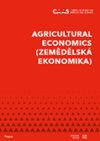印尼粗棕榈油对主要目的国的出口强度和竞争力
IF 1.8
4区 经济学
Q2 AGRICULTURAL ECONOMICS & POLICY
引用次数: 6
摘要
棕榈油是一种来自印度尼西亚的优质产品,不断被广泛用于烹饪、美容和制造业等日常需求。然而,这种潜力必须得到油棕商业参与者的表现的支持,以保持其强度和竞争力。本研究采用面板回归和基本重力模型,探讨了各种因素对印尼粗棕榈油出口强度和竞争力的影响。这里使用的面板数据是一个20年的时间序列,包括1999年至2018年五个主要进口商的横截面。结果表明,进口国的国内生产总值(GDP)和出口数量显著正向影响印尼的CPO出口强度,而出口国的GDP和经济距离具有显著负向影响。对竞争力产生正向显著影响的因素是大豆进口价值和可持续棕榈油圆桌会议(RSPO)认证,而马来西亚CPO出口和进口国人口对印尼CPO竞争力产生负向影响。本文章由计算机程序翻译,如有差异,请以英文原文为准。
Export intensity and competitiveness of Indonesia's crude palm oil to main destination countries
Palm oil is a superior product from Indonesia that is continuously and widely used for daily needs such as cooking, grooming, and manufacturing. However, this potential must be supported by oil palm business actors' performance to maintain its intensity and competitiveness. This study investigates how various factors affect Indonesia's crude palm oil (CPO) export intensity and competitiveness by employing panel regression and the basic gravity model. The panel data used here is a 20-year time series with cross-sections from five major importers from 1999 to 2018. The results show that the importer's gross domestic product (GDP) and quantity of export significantly and positively affect Indonesia's CPO export intensity, while the exporter's GDP and economic distance has a significant and negative effect. The factors that positively and significantly influence competitiveness are soybean's import value and Roundtable on Sustainable Palm Oil (RSPO) certification, while Malaysian CPO's export and population of importing countries negatively affect Indonesian CPO competitiveness.
求助全文
通过发布文献求助,成功后即可免费获取论文全文。
去求助
来源期刊

Agricultural Economics-Zemedelska Ekonomika
Agricultural Economics & Policy-
CiteScore
4.30
自引率
4.50%
发文量
47
审稿时长
30 weeks
期刊介绍:
An international peer-reviewed journal published under the auspices of the Czech Academy of Agricultural Sciences and financed by the Ministry of Agriculture of the Czech Republic. Published since 1954 (by 1999 under the title Zemědělská ekonomika).Thematic scope:
original scientific papers dealing with agricultural subjects from the sphere of economics, management, informatics, ecology, social economy and sociology. Since 1993 the papers continually treat problems which were published in the journal Sociologie venkova a zemědělství until now. An extensive scope of subjects in fact covers the whole of agribusiness, that means economic relations of suppliers and producers of inputs for agriculture and food industry, problems from the aspects of social economy and rural sociology and finally the economics of the population nutrition. Papers are published in English.
 求助内容:
求助内容: 应助结果提醒方式:
应助结果提醒方式:


